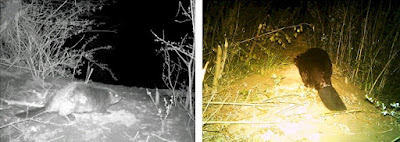The wild life of Tuscany is by no means static. For example, several species of deer plus wild boar were rare in the Chianti Classico wine zone of Tuscany 80 year ago. They're now so common as to be a pest to the extent that most vineyards are have to be surrounded by high mess fences to keep them out. Now that these ungulate populations are out of control, wolves have made an appearance over the past 2-3 years, presumably having migrated down from the Apennines to easy pickings in Chianti.
Another pest is the nutria or coypu, a rodent that resembles a beaver but lacks its flat tail. Some years back, these rodents escaped from breeding facilities where they were raised for their pelts. They are now found in rivers and steams all over Italy, and cause damage by burrowing into stream banks, causing collapse of the ground along waterways.
Nutria or coypu (Myocastor coypus)
Historically, true beavers used to be very common all across Europe. However, due to hunting for their pelts, beavers became almost extinct. In several countries, reintroduction projects successfully brought back the beaver. In Italy, the beaver remained absent until at least one was reported in the Friuli-Venezia Giulia region in the Tarvisiano woods, about 3 years ago. This individual and possibly others probably migrated over the Alps from Austria.
Beavers in Tuscany
Over the past two years, there has been photographic confirmation that the Eurasian beaver Castor fiber L. has re-appeared in the wild Tuscany for the first time in more than 500 years. There are at least a couple of colonies, one sighted in the province of Arezzo, in Valtiberina, along the Tiber river. Another on the border between the provinces of Sienna and Grosseto. Local freelance wild life technicians and government scientists, Chiara Pucci, Davide Senserini, Giuseppe Mazza and Emiliano Mori, confirmed the occurrence of beavers through camera trapping. Genetic analyses (cytochrome-b mitochondrial gene) and hair microstructure confirmed the beavers to be the Eurasian species now in a new range about 530 km south to the historical range for this species. The presence of a relict population in this area is unlikely and the researchers therefore suggest that these newly reported beavers are the result of unauthorised releases. A recent radio broadcast by Radio 24 suggested that the Tuscan beavers are escapees from a small zoo near Aretino, but this can be ruled out by the genetic analysis.
Beavers photographed at night in Tuscany
More about the fauna of the Val d'Elsa.
|
Author: Anna Maria Baldini




